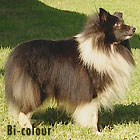Breed: Shetland Sheepdog (Sheltie)
Temperament: intelligent, alert, easy going
Lifespan: 12-16 years
Maintenance: medium
Recommended for: elderly, dog sport enthusiasts, small yards
History
The Shetland Islands, for all their beauty, can be a cold and inhospitable place to live. Located at the crossroads of the North Sea, the islands’ inhabitants have been influenced by passing invaders, traders, visitors and settlers over many centuries. The Shetland Sheepdog is one example of this influence. Otherwise known as the ‘Sheltie’, it is the product of matings between Rough Coated Collies, a breed native to Scotland, and various spaniel and spitz-type breeds from visiting fishing and trade boats.
The progeny of these ‘sailor dogs’ and collies proved to become especially suited to this harsh, rugged terrain. The Sheltie became a multi-purpose breed, able to protect the small farms or ‘crofts’ whilst also showing particular skill as a working dog amongst stock. The island’s miniature cattle, tiny sheep and Shetland Ponies were all herded by these equally small sheepdogs. Despite its presence for many years, it was not until 1914 that the breed was officially named the Shetland Sheepdog.
Appearance
It is understandable how the Sheltie is often mistaken for a collie pup. The long haired working dog closely resembles the Rough Coated Collie in many ways apart from size (remember the many adventures of Lassie? Well she was a Rough Coated Collie). Sheltie’s are in fact quite small, standing around 37 centimetres tall at the wither, around half the size of a Collie. Though small, Shelties are regarded by their owners as a breed of great beauty. The refined appearance of the breed is accentuated by the elegant head and a mane-like frill of abundant, long hair which envelops the shoulders and chest. The most common colours in Australia are sable, ranging from a pale gold to deep chocolate with white trimmings; a tri-colour of black with tan and white points; and the blue merle, blue with tan and white points. Other colours less often seen are the bi-colours of blue with white points or black with white points.
Temperament
Shelties are an intelligent breed and very responsive to training. Though loyal to their owners, Shelties are known to be timid and wary of strangers if not encouraged to socialise. Although Australian lines are not used amongst stock, they do retain their guarding instincts and will alert their owners of visitors. Once settled, a Sheltie pup is quick to consider itself a member of the family and will be quite happy to follow its owners around all day. Because of their adeptness to training, many Shelties in Australia excel in dog activities such as the show ring, tracking, flyball, agility and of course obedience.
Health and lifespan
The Shetland Sheepdog is generally regarded as a sound breed. Not to be mistaken for a dwarf Collie (a Collie with a normal body but very short legs), the Sheltie is in fact a miniature. So the many health problems associated with dwarfism are absent from this breed. However miniaturisation has brought with it its own health concerns, particulary inherited eye conditions such as Collie Eye Anomaly and Progressive Retina Atrophy, both of which can lead to blindness. Diligent Australian breeders do test for these conditions, as with hip dysplasia, so they should not be evident in most progeny. Ask the breeder for confirmation that the dogs have been tested. Keep in mind that Shelties are also prone to getting quite fat, so watch how much you feed. Finally, don’t forget the teeth. They can be a problem in the breed so give them plenty of raw bones from a very early age to avoid concerns. They’re long lived dogs, expect your little companion to be around for 12-16 years.
Care and exercise
Some commitment must be shown to keep the long, coarse coat in good order, though grooming is relatively easy and the coarse coat is resistant to knots. A weekly brush removing dead hair and matting should suffice. Shelties will shed once a year, generally approaching autumn, and require more regular brushing at this time. Bitches will shed more often than dogs. Overheating during the hotter months is only a problem if the dog is over-exerted and clipping is not usually necessary. These small dogs cope well in a small yard, and although Shelties enjoy a run, there is no need for exhausting treks over hill and dale to burn off excess energy.
Recommended for
Shetland Sheepdogs make equally great pets for those of us with a quiet lifestyle or those perhaps interested in dog sports. Great with children, the elderly, or anyone alone at home who wants a calm canine companion, shelties don’t demand much space and are wonderful watchdogs. Litters are small, usually from one to four pups, so interested owners can expect to wait up to six months for a pup. Prices range from around $600 for a pet to around $800 for a show dog.
National contacts
To find up-to-date contacts for breeders, contact the following organisations.
Dogs NSW
http://www.dogsnsw.org.au/breeders-directory
Email: [email protected]
Phone: 1300 728 022 (NSW only) or (02) 9834 3022
Fax: (02) 9834 3872
Dogs Victoria
http://www.vca.org.au
Email: [email protected]
Phone: (03) 9788 2500
Fax: (03) 9788 2599
Dogs ACT
http://www.actca.asn.au
Email: [email protected]
Phone: (02) 6241 4404 – Fax: (02) 6241 1129.
Dogs West
http://www.cawa.asn.au
Email: [email protected]
Phone: (08) 9455 1188
Fax: (08) 9455 1190
Dogs SA
http://dogssa.com.au
Phone: (08) 8349 4797
Canine Control Council of Queensland
http://www.cccq.org.au
Email: [email protected]
Phone: (07) 3252 2661
Fax: (07) 3252 3864
Tasmanian Canine Association
http://www.tasdogs.com
Email: [email protected]
Phone: (03) 6272 9443
Fax: (03) 6273 0844
Dogs NT
http://www.territorydogworld.com
Email: [email protected]
Phone: (08) 8984 3570
Fax: (08) 8984 3409



